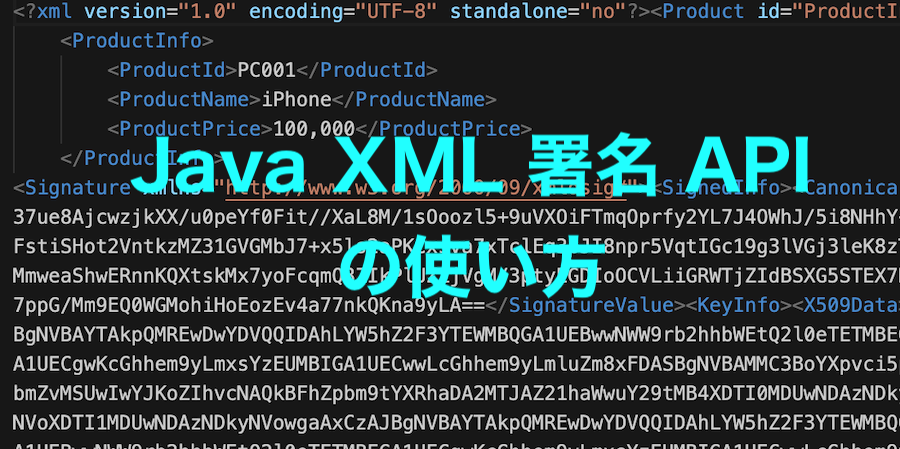署名編の評判が良いようなので、次は検証(Validation)編。
と思ったのだが、オラクル公式サンプルが興味深かったので再掲。
レビューしてみる。
そのコードはこうだ。
import javax.xml.crypto.*;
import javax.xml.crypto.dsig.*;
import javax.xml.crypto.dom.*;
import javax.xml.crypto.dsig.dom.DOMValidateContext;
import javax.xml.crypto.dsig.keyinfo.*;
import java.io.FileInputStream;
import java.security.*;
import java.util.Collections;
import java.util.Iterator;
import java.util.List;
import javax.xml.parsers.DocumentBuilderFactory;
import org.w3c.dom.Document;
import org.w3c.dom.NodeList;
/**
* This is a simple example of validating an XML
* Signature using the JSR 105 API. It assumes the key needed to
* validate the signature is contained in a KeyValue KeyInfo.
*/
public class Validate {
//
// Synopsis: java Validate [document]
//
// where "document" is the name of a file containing the XML document
// to be validated.
//
public static void main(String[] args) throws Exception {
// Instantiate the document to be validated
DocumentBuilderFactory dbf = DocumentBuilderFactory.newInstance();
dbf.setNamespaceAware(true);
Document doc =
dbf.newDocumentBuilder().parse(new FileInputStream(args[0]));
// Find Signature element
NodeList nl =
doc.getElementsByTagNameNS(XMLSignature.XMLNS, "Signature");
if (nl.getLength() == 0) {
throw new Exception("Cannot find Signature element");
}
// Create a DOM XMLSignatureFactory that will be used to unmarshal the
// document containing the XMLSignature
XMLSignatureFactory fac = XMLSignatureFactory.getInstance("DOM");
// Create a DOMValidateContext and specify a KeyValue KeySelector
// and document context
DOMValidateContext valContext = new DOMValidateContext
(new KeyValueKeySelector(), nl.item(0));
// unmarshal the XMLSignature
XMLSignature signature = fac.unmarshalXMLSignature(valContext);
// Validate the XMLSignature (generated above)
boolean coreValidity = signature.validate(valContext);
// Check core validation status
if (coreValidity == false) {
System.err.println("Signature failed core validation");
boolean sv = signature.getSignatureValue().validate(valContext);
System.out.println("signature validation status: " + sv);
// check the validation status of each Reference
Iterator i = signature.getSignedInfo().getReferences().iterator();
for (int j=0; i.hasNext(); j++) {
boolean refValid =
((Reference) i.next()).validate(valContext);
System.out.println("ref["+j+"] validity status: " + refValid);
}
} else {
System.out.println("Signature passed core validation");
}
}
/**
* KeySelector which retrieves the public key out of the
* KeyValue element and returns it.
* NOTE: If the key algorithm doesn't match signature algorithm,
* then the public key will be ignored.
*/
private static class KeyValueKeySelector extends KeySelector {
public KeySelectorResult select(KeyInfo keyInfo,
KeySelector.Purpose purpose,
AlgorithmMethod method,
XMLCryptoContext context)
throws KeySelectorException {
if (keyInfo == null) {
throw new KeySelectorException("Null KeyInfo object!");
}
SignatureMethod sm = (SignatureMethod) method;
List list = keyInfo.getContent();
for (int i = 0; i < list.size(); i++) {
XMLStructure xmlStructure = (XMLStructure) list.get(i);
if (xmlStructure instanceof KeyValue) {
PublicKey pk = null;
try {
pk = ((KeyValue)xmlStructure).getPublicKey();
} catch (KeyException ke) {
throw new KeySelectorException(ke);
}
// make sure algorithm is compatible with method
if (algEquals(sm.getAlgorithm(), pk.getAlgorithm())) {
return new SimpleKeySelectorResult(pk);
}
}
}
throw new KeySelectorException("No KeyValue element found!");
}
//@@@FIXME: this should also work for key types other than DSA/RSA
static boolean algEquals(String algURI, String algName) {
if (algName.equalsIgnoreCase("DSA") &&
algURI.equalsIgnoreCase(SignatureMethod.DSA_SHA1)) {
return true;
} else if (algName.equalsIgnoreCase("RSA") &&
algURI.equalsIgnoreCase(SignatureMethod.RSA_SHA1)) {
return true;
} else {
return false;
}
}
}
private static class SimpleKeySelectorResult implements KeySelectorResult {
private PublicKey pk;
SimpleKeySelectorResult(PublicKey pk) {
this.pk = pk;
}
public Key getKey() { return pk; }
}
}このコード自体はそんなにおかしくないと思うかもしれないが、対象となる xml ファイルも掲示されていてそれはこういうものだ。
<Envelope xmlns="urn:envelope">
<Signature xmlns="http://www.w3.org/2000/09/xmldsig#">
<SignedInfo xmlns="http://www.w3.org/2000/09/xmldsig#">
<CanonicalizationMethod xmlns="http://www.w3.org/2000/09/xmldsig#" Algorithm="http://www.w3.org/TR/2001/REC-xml-c14n-20010315#WithComments"/>
<SignatureMethod xmlns="http://www.w3.org/2000/09/xmldsig#" Algorithm="http://www.w3.org/2000/09/xmldsig#dsa-sha1"/>
<Reference xmlns="http://www.w3.org/2000/09/xmldsig#" URI="">
<Transforms xmlns="http://www.w3.org/2000/09/xmldsig#">
<Transform xmlns="http://www.w3.org/2000/09/xmldsig#" Algorithm="http://www.w3.org/2000/09/xmldsig#enveloped-signature"/>
</Transforms>
<DigestMethod xmlns="http://www.w3.org/2000/09/xmldsig#" Algorithm="http://www.w3.org/2000/09/xmldsig#sha1"/>
<DigestValue xmlns="http://www.w3.org/2000/09/xmldsig#">uooqbWYa5VCqcJCbuymBKqm17vY=</DigestValue>
</Reference>
</SignedInfo>
<SignatureValue xmlns="http://www.w3.org/2000/09/xmldsig#">eO7K1BdC0kzNvr1HpMf4hKoWsvl+oI04nMw55GO+Z5hyI6By3Oihow==</SignatureValue>
<KeyInfo xmlns="http://www.w3.org/2000/09/xmldsig#">
<KeyValue xmlns="http://www.w3.org/2000/09/xmldsig#">
<DSAKeyValue xmlns="http://www.w3.org/2000/09/xmldsig#">
<P xmlns="http://www.w3.org/2000/09/xmldsig#">/KaCzo4Syrom78z3EQ5SbbB4sF7ey80etKII864WF64B81uRpH5t9jQTxeEu0ImbzRMqzVDZkVG9 xD7nN1kuFw==</P>
<Q xmlns="http://www.w3.org/2000/09/xmldsig#">li7dzDacuo67Jg7mtqEm2TRuOMU=</Q>
<G xmlns="http://www.w3.org/2000/09/xmldsig#">Z4Rxsnqc9E7pGknFFH2xqaryRPBaQ01khpMdLRQnG541Awtx/XPaF5Bpsy4pNWMOHCBiNU0Nogps QW5QvnlMpA==</G>
<Y xmlns="http://www.w3.org/2000/09/xmldsig#">OqFi0sGpvroi6Ut3m154QNWc6gavH3j2ZoRPDW7qVBbgk7XompuKvZe1owz0yvxq+1K+mWbL7ST+ t5nr6UFBCg==</Y>
</DSAKeyValue>
</KeyValue>
</KeyInfo>
</Signature>
</Envelope>これを NetBeans あたりで実行すると(ちなみに Java17 あたりでもほとんど手直しなしで動く)エラーが出てきて、そのメッセージはなかなか興味深い。
Exception in thread "main" javax.xml.crypto.MarshalException: It is forbidden to use algorithm http://www.w3.org/2000/09/xmldsig#dsa-sha1 when secure validation is enabled要するに dsa-sha1 が現在ではセキュリティ的に問題あるので使えませんよ、と警告してくれるわけだ。
また、Signature 要素を探すとき doc.getElementsByTagNameNS メソッドを使っていて、なんでだ?と訝しんでいたのだが、対象となる xml を眺めてなんか納得。

